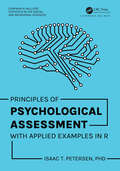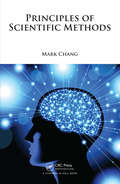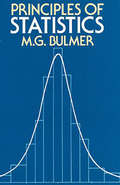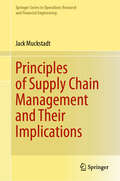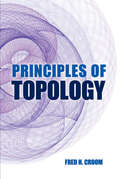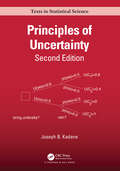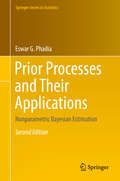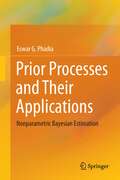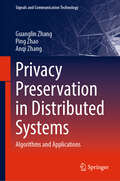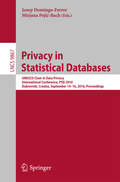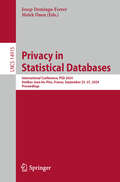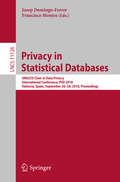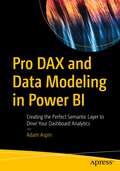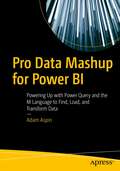- Table View
- List View
Principles of Optimal Design
by Douglass J. Wilde Panos Y. PapalambrosPrinciples of Optimal Design puts the concept of optimal design on a rigorous foundation and demonstrates the intimate relationship between the mathematical model that describes a design and the solution methods that optimize it. Since the first edition was published, computers have become ever more powerful, design engineers are tackling more complex systems, and the term optimization is now routinely used to denote a design process with increased speed and quality. This second edition takes account of these developments and brings the original text thoroughly up to date. The book now includes a discussion of trust region and convex approximation algorithms. A new chapter focuses on how to construct optimal design models. Three new case studies illustrate the creation of optimization models. The final chapter on optimization practice has been expanded to include computation of derivatives, interpretation of algorithmic results, and selection of algorithms and software. Both students and practising engineers will find this book a valuable resource for design project work.
Principles of Psychological Assessment: With Applied Examples in R (Chapman & Hall/CRC Statistics in the Social and Behavioral Sciences)
by Isaac T. PetersenThis book highlights the principles of psychological assessment to help researchers and clinicians better develop, evaluate, administer, score, integrate, and interpret psychological assessments. It discusses psychometrics (reliability and validity), the assessment of various psychological domains (behavior, personality, intellectual functioning), various measurement methods (e.g., questionnaires, observations, interviews, biopsychological assessments, performance-based assessments), and emerging analytical frameworks to evaluate and improve assessment including: generalizability theory, structural equation modeling, item response theory, and signal detection theory. The text also discusses ethics, test bias, and cultural and individual diversity.Key Features Gives analysis examples using free software Helps readers apply principles to research and practice Provides text, analysis code/syntax, R output, figures, and interpretations integrated to guide readers Uses the freely available petersenlab package for R Principles of Psychological Assessment: With Applied Examples in R is intended for use by graduate students, faculty, researchers, and practicing psychologists.
Principles of Scientific Methods
by Mark ChangThis book focuses on the fundamental principles behind scientific methods. The author uses concrete examples to explain principles. He also uses analogies to connect different methods or problems to arrive at a general principle or common notion. The book explores how the principles of scientific methods are not only applicable to scientific research but also in our daily lives. It shows how the scientific method is used to understand how and why things happen, make predictions, prevent mistakes, and solve problems.
Principles of Statistical Inference
by D. R. CoxIn this definitive book, D. R. Cox gives a comprehensive and balanced appraisal of statistical inference. He develops the key concepts, describing and comparing the main ideas and controversies over foundational issues that have been keenly argued for more than two-hundred years. Continuing a sixty-year career of major contributions to statistical thought, no one is better placed to give this much-needed account of the field. An appendix gives a more personal assessment of the merits of different ideas. The content ranges from the traditional to the contemporary. While specific applications are not treated, the book is strongly motivated by applications across the sciences and associated technologies. The mathematics is kept as elementary as feasible, though previous knowledge of statistics is assumed. The book will be valued by every user or student of statistics who is serious about understanding the uncertainty inherent in conclusions from statistical analyses.
Principles of Statistics
by M. G. BulmerThere are many textbooks which describe current methods of statistical analysis, while neglecting related theory. There are equally many advanced textbooks which delve into the far reaches of statistical theory, while bypassing practical applications. But between these two approaches is an unfilled gap, in which theory and practice merge at an intermediate level. Professor M. G. Bulmer's Principles of Statistics, originally published in 1965, was created to fill that need. The new, corrected Dover edition of Principles of Statistics makes this invaluable mid-level text available once again for the classroom or for self-study. Principles of Statistics was created primarily for the student of natural sciences, the social scientist, the undergraduate mathematics student, or anyone familiar with the basics of mathematical language. It assumes no previous knowledge of statistics or probability; nor is extensive mathematical knowledge necessary beyond a familiarity with the fundamentals of differential and integral calculus. (The calculus is used primarily for ease of notation; skill in the techniques of integration is not necessary in order to understand the text.)Professor Bulmer devotes the first chapters to a concise, admirably clear description of basic terminology and fundamental statistical theory: abstract concepts of probability and their applications in dice games, Mendelian heredity, etc.; definitions and examples of discrete and continuous random variables; multivariate distributions and the descriptive tools used to delineate them; expected values; etc. The book then moves quickly to more advanced levels, as Professor Bulmer describes important distributions (binomial, Poisson, exponential, normal, etc.), tests of significance, statistical inference, point estimation, regression, and correlation. Dozens of exercises and problems appear at the end of various chapters, with answers provided at the back of the book. Also included are a number of statistical tables and selected references.
Principles of Stellar Interferometry
by Andreas GlindemannThe imaging process in stellar interferometers is explained starting from first principles on wave propagation and diffraction. Wave propagation through turbulence is described in detail using Kolmogorov statistics. The impact of turbulence on the imaging process is discussed both for single telescopes and for interferometers. Correction methods (adaptive optics and fringe tracking) are presented including wavefront sensing/fringe sensing methods and closed loop operation. Instrumental techniques like beam combination and visibility measurements (modulus and phase) as well as Nulling and heterodyne interferometry are described. The book closes with examples of observing programmes linking the theory with individual astrophysical programmes.
Principles of Supply Chain Management and Their Implications (Springer Series in Operations Research and Financial Engineering)
by Jack MuckstadtThe text begins with a discussion of the basic principles of supply chain management and some attributes of certain industries. The remainder of the text is devoted to developing and applying mathematical concepts needed to address the many issues associated with managing supply chains and, in particular, uncertainty, in a variety of real world settings. In particular, the final chapter is devoted to the design and operation of a vaccine distribution system during a pandemic along with a critique of the way the system used in the United States performed.
Principles of Topology (Dover Books on Mathematics)
by Fred H. CroomTopology is a natural, geometric, and intuitively appealing branch of mathematics that can be understood and appreciated by students as they begin their study of advanced mathematical topics. Designed for a one-semester introduction to topology at the undergraduate and beginning graduate levels, this text is accessible to students familiar with multivariable calculus. Rigorous but not abstract, the treatment emphasizes the geometric nature of the subject and the applications of topological ideas to geometry and mathematical analysis.Customary topics of point-set topology include metric spaces, general topological spaces, continuity, topological equivalence, basis, subbasis, connectedness, compactness, separation properties, metrization, subspaces, product spaces, and quotient spaces. In addition, the text introduces geometric, differential, and algebraic topology. Each chapter includes historical notes to put important developments into their historical framework. Exercises of varying degrees of difficulty form an essential part of the text.
Principles of Uncertainty (Chapman & Hall/CRC Texts in Statistical Science)
by Joseph B. KadanePraise for the first edition: Principles of Uncertainty is a profound and mesmerising book on the foundations and principles of subjectivist or behaviouristic Bayesian analysis. … the book is a pleasure to read. And highly recommended for teaching as it can be used at many different levels. … A must-read for sure!—Christian Robert, CHANCEIt's a lovely book, one that I hope will be widely adopted as a course textbook.—Michael Jordan, University of California, Berkeley, USALike the prize-winning first edition, Principles of Uncertainty, Second Edition is an accessible, comprehensive text on the theory of Bayesian Statistics written in an appealing, inviting style, and packed with interesting examples. It presents an introduction to the subjective Bayesian approach which has played a pivotal role in game theory, economics, and the recent boom in Markov Chain Monte Carlo methods. This new edition has been updated throughout and features new material on Nonparametric Bayesian Methods, the Dirichlet distribution, a simple proof of the central limit theorem, and new problems.Key Features: First edition won the 2011 DeGroot Prize Well-written introduction to theory of Bayesian statistics Each of the introductory chapters begins by introducing one new concept or assumption Uses "just-in-time mathematics"—the introduction to mathematical ideas just before they are applied
Principles to Actions: Ensuring Mathematical Success for All
by National Council of Teachers of MathematicsWhat it will take to turn the opportunity of the Common Core into reality in every classroom, school, and district. <p><p> Continuing its tradition of mathematics education leadership, NCTM has undertaken a major initiative to define and describe the principles and actions, including specific teaching practices, that are essential for a high-quality mathematics education for all students. <p> This landmark new title offers guidance to teachers, mathematics coaches, administrators, parents, and policymakers: <p> Provides a research-based description of eight essential Mathematics Teaching Practices <p> Describes the conditions, structures, and policies that must support the Teaching Practices <p> Builds on NCTM's Principles and Standards for School Mathematics and supports implementation of the Common Core State Standards for Mathematics to attain much higher levels of mathematics achievement for all students <p> Identifies obstacles, unproductive and productive beliefs, and key actions that must be understood, acknowledged, and addressed by all stakeholders <p> Encourages teachers of mathematics to engage students in mathematical thinking, reasoning, and sense making to significantly strengthen teaching and learning
Prior Processes and Their Applications
by Eswar G. PhadiaThis book presents a systematic and comprehensive treatment of various prior processes that have been developed over the past four decades for dealing with Bayesian approach to solving selected nonparametric inference problems. This revised edition has been substantially expanded to reflect the current interest in this area. After an overview of different prior processes, it examines the now pre-eminent Dirichlet process and its variants including hierarchical processes, then addresses new processes such as dependent Dirichlet, local Dirichlet, time-varying and spatial processes, all of which exploit the countable mixture representation of the Dirichlet process. It subsequently discusses various neutral to right type processes, including gamma and extended gamma, beta and beta-Stacy processes, and then describes the Chinese Restaurant, Indian Buffet and infinite gamma-Poisson processes, which prove to be very useful in areas such as machine learning, information retrieval and featural modeling. Tailfree and Polya tree and their extensions form a separate chapter, while the last two chapters present the Bayesian solutions to certain estimation problems pertaining to the distribution function and its functional based on complete data as well as right censored data. Because of the conjugacy property of some of these processes, most solutions are presented in closed form. However, the current interest in modeling and treating large-scale and complex data also poses a problem - the posterior distribution, which is essential to Bayesian analysis, is invariably not in a closed form, making it necessary to resort to simulation. Accordingly, the book also introduces several computational procedures, such as the Gibbs sampler, Blocked Gibbs sampler and slice sampling, highlighting essential steps of algorithms while discussing specific models. In addition, it features crucial steps of proofs and derivations, explains the relationships between different processes and provides further clarifications to promote a deeper understanding. Lastly, it includes a comprehensive list of references, equipping readers to explore further on their own.
Prior Processes and Their Applications: Nonparametric Bayesian Estimation
by Eswar G. PhadiaThis book presents a systematic and comprehensive treatment of various prior processes that have been developed over the last four decades in order to deal with the Bayesian approach to solving some nonparametric inference problems. Applications of these priors in various estimation problems are presented. Starting with the famous Dirichlet process and its variants, the first part describes processes neutral to the right, gamma and extended gamma, beta and beta-Stacy, tail free and Polya tree, one and two parameter Poisson-Dirichlet, the Chinese Restaurant and Indian Buffet processes, etc., and discusses their interconnection. In addition, several new processes that have appeared in the literature in recent years and which are off-shoots of the Dirichlet process are described briefly. The second part contains the Bayesian solutions to certain estimation problems pertaining to the distribution function and its functional based on complete data. Because of the conjugacy property of some of these processes, the resulting solutions are mostly in closed form. The third part treats similar problems but based on right censored data. Other applications are also included. A comprehensive list of references is provided in order to help readers explore further on their own.
Prisoners of Reason
by S. m. AmadaeIs capitalism inherently predatory? Must there be winners and losers? Is public interest outdated and free-riding rational? Is consumer choice the same as self-determination? Must bargainers abandon the no-harm principle? Prisoners of Reason recalls that classical liberal capitalism exalted the no-harm principle. Although imperfect and exclusionary, modern liberalism recognized individual human dignity alongside individuals' responsibility to respect others. Neoliberalism, by contrast, views life as ceaseless struggle. Agents vie for scarce resources in antagonistic competition in which every individual seeks dominance. This political theory is codified in non-cooperative game theory; the neoliberal citizen and consumer is the strategic rational actor. Rational choice justifies ends irrespective of means. Money becomes the medium of all value. Solidarity and good will are invalidated. Relationships are conducted on a quid pro quo basis. However, agents can freely opt out of this cynical race to the bottom by embracing a more expansive range of coherent action.
Privacy Preservation in Distributed Systems: Algorithms and Applications (Signals and Communication Technology)
by Anqi Zhang Ping Zhao Guanglin ZhangThis book provides a discussion of privacy in the following three parts: Privacy Issues in Data Aggregation; Privacy Issues in Indoor Localization; and Privacy-Preserving Offloading in MEC. In Part 1, the book proposes LocMIA, which shifts from membership inference attacks against aggregated location data to a binary classification problem, synthesizing privacy preserving traces by enhancing the plausibility of synthetic traces with social networks. In Part 2, the book highlights Indoor Localization to propose a lightweight scheme that can protect both location privacy and data privacy of LS. In Part 3, it investigates the tradeoff between computation rate and privacy protection for task offloading a multi-user MEC system, and verifies that the proposed load balancing strategy improves the computing service capability of the MEC system. In summary, all the algorithms discussed in this book are of great significance in demonstrating the importance of privacy.
Privacy Preserving Data Management: Assisting Users in Data Disclosure Scenarios (Technology, Peace and Security I Technologie, Frieden und Sicherheit)
by Sebastian LinsnerUsers face many situations in which they have to disclose their data to others. In many cases, they are not properly informed about the usage of their data or the consequences of data disclosure. This book investigates how users can be supported by researching three core aspects: Firstly, problems and risks that lead to (unintended) data disclosure or arise from it have to be identified. Secondly, measures are investigated that developers can apply to mitigate these risks and meet the needs of the users. Finally, the developed solutions have to be adopted into practice. Strategies to bring security- and privacy-enhancing technologies to use are essential because a tool that is not used cannot protect anyone. The investigated scenarios are twofold: Firstly, business-to-business (B2B) collaborations, especially highlighting the perspective of owners of small and medium enterprises (SMEs) who are forced to provide data for business processes. Secondly, scenarios of everyday usage for private users that require the disclosure of data are investigated.
Privacy Symposium 2024: Data Protection Law International Convergence and Compliance with Innovative Technologies (DPLICIT)
by Stefan Schiffner Jaap-Henk Hoepman Sébastien Ziegler Maria Grazia Porcedda Meiko JensenThis book presents the proceedings of the Privacy Symposium 2024. The book features a collection of high-quality research works and professional perspectives on personal data protection and emerging technologies. Gathering legal and technology expertise, it provides cutting-edge perspective on international data protection regulations convergence, as well as data protection compliance of emerging technologies, such as artificial intelligence, e-health, blockchain, edge computing, Internet of Things, V2X, and smart grid. Papers encompass various topics, including international law and comparative law in data protection and compliance, cross-border data transfer, emerging technologies and data protection compliance, data protection by design, technology for compliance and data protection, data protection good practices across industries and verticals, cybersecurity and data protection, assessment and certification of data protection compliance, and data subject rights implementation.
Privacy in Statistical Databases
by Josep Domingo-Ferrer Mirjana Pejić-BachThis book constitutes the refereed proceedings of the International Workshop on Privacy in Statistical Databases, PSD 2004, held in June 2004 in Barcelona, Spain as the final conference of the European IST Project Computational Aspects of Statistical Confidentiality. The 29 revised full papers presented were carefully reviewed and selected from 44 submissions. The papers are organized in topical sections on foundations of tabular protection, methods for tabular protection, masking for microdata protection, risks in microdata protection, synthetic data, and software and case studies.
Privacy in Statistical Databases: International Conference, PSD 2024, Antibes Juan-les-Pins, France, September 25–27, 2024, Proceedings (Lecture Notes in Computer Science #14915)
by Josep Domingo-Ferrer Melek ÖnenThis book constitutes the refereed proceedings of the International Conference on Privacy in Statistical Databases, PSD 2024, held in Antibes Juan-les-Pins, France, during September 25-27, 2024. The 28 papers presented in this volume were carefully reviewed and selected from 46 submissions. They were organized in topical sections as follows: Privacy models and concepts; Microdata protection; Statistical table protection; Synthetic data generation methods; Synthetic data generation software; Disclosure risk assessment; Spatial and georeferenced data; Machine learning and privacy; and Case studies.
Privacy in Statistical Databases: UNESCO Chair in Data Privacy, International Conference, PSD 2018, Valencia, Spain, September 26–28, 2018, Proceedings (Lecture Notes in Computer Science #11126)
by Josep Domingo-Ferrer Francisco MontesThis book constitutes the refereed proceedings of the International Conference on Privacy in Statistical Databases, PSD 2018, held in Valencia, Spain, in September 2018 under the sponsorship of the UNESCO Chair in Data Privacy. The 23 revised full papers presented were carefully reviewed and selected from 42 submissions. The papers are organized into the following topics: tabular data protection; synthetic data; microdata and big data masking; record linkage; and spatial and mobility data.Chapter "SwapMob: Swapping Trajectories for Mobility Anonymization" is available open access under a Creative Commons Attribution 4.0 International License via link.springer.com.
Privacy in the Age of Innovation: AI Solutions for Information Security
by Ranadeep Reddy Palle Krishna Chaitanya KathalaThis book will help you comprehend the impact of artificial intelligence (AI) on information security, data privacy, and data security.The book starts by explaining the basics and setting the goals for a complete understanding of how AI, Information Security, Data Privacy, and Data Security all connect. Then, it gives you important information about the basics of AI, machine learning, and deep learning in simple terms. It also talks about the ethics of using AI in privacy and security, making sure you understand the power and responsibility that come with AI. Next, it takes you through the complex world of information security and data privacy. It covers everything from the current state of security to how AI can detect threats and protect privacy. Additionally, it delves into ethical considerations to ensure the responsible use of AI in managing data privacy. Later chapters discuss strategies and future trends in using AI for data security, finding the right balance between security and privacy, and giving useful advice for organizations.In the end, this book examines the current landscape and foresees the future, underscoring the vital importance of maintaining a balance between innovation and privacy in AI-powered security.What you will learn:How AI is being used to detect and prevent cyberattacks in real-timeWhat are the AI-powered techniques for anonymizing and de-identifying data,What are the latest advancements in AI-powered privacy-enhancing technologies (PETs)How to find the right balance between security and privacyWho this book is for:Information security professionals, data scientists, and software developers seeking to gain an understanding of the latest trends and techniques in AI for information security
Private Equity Firms: Their Role in the Formation of Strategic Alliances
by Kirsten BurkhardtThis work analyzes the role of private equity firms (SCIs) in forming strategic alliances in the French private equity market. The subject is important because the formation of alliances and, more generally, the networking of SMEs, could be an alternative to the lack of medium-sized companies in France. For French SCIs, which are increasingly in a competitive situation, assistance in forming alliances for their holdings may represent a new activity and be a source of competitive advantage. The work is positioned transversally, touching the areas of corporate governance, entrepreneurial finance and strategy.
Private Higher Education and Inequalities in the Global South: Lessons from Africa, Latin America and Asia (Demographic Transformation and Socio-Economic Development #17)
by Etienne GérardBased on original findings from research carried out in six low- and middle-income countries in Africa, Asia and Latin America, this book brings together conceptual and empirical analyses of private higher education and social and academic inequality, a topic largely unexplored in the social science literature, particularly on private higher education. Field surveys of different categories of actors in numerous private universities have combined common methods and tools in countries chosen for the differences in their social structures and the characteristics, organization and development of their private higher education systems. Based on these qualitative surveys, combined with available quantitative data on higher education, this book analyzes the production and reproduction of social and academic inequalities in countries as diverse as Argentina, Malaysia, Mexico, Peru, the Democratic Republic of Congo, Senegal and Vietnam. Finally, the historical and social structuringof the private education systems in the selected countries provides the framework for analyses that go beyond the traditional higher education demand/supply and public policy approaches to explore the perspective of the actors – institutional administrators, teaching staff and students.
Private Tutor - SAT Math 2013-2014 Prep Course
by Amy LucasThe purchase of this eBook includes an offer for a FREE DVD or Digital Download of 2 hours from our 20-hour SAT prep video course. Private Tutor SAT Math 2013-2014 Prep Course is a critically-praised, low cost alternative to the often unaffordable tutoring industry. Students can achieve the results of private tutoring at a fraction of the cost. This complete course covers all aspects of the SAT Math sections including numerous practice drills with detailed answer explanations. Written by Amy Lucas, a Summa Cum Laude graduate of UCLA with fifteen years of experience as an SAT Master Tutor and Education Specialist. The School Library Journal Starred Review stated "Library collections serving high school students as well as homeschoolers seeking instruction, practice, and basic standardized test-taking tips for the Math SAT will find this series an essential purchase." The Library Journal stated, " Verdict: highly recommended for students taking the SATs." Math book can be used alone or with the corresponding 10-hour DVD course. * Achieve the results of Private Tutoring at a fraction of the cost! * SAT Math Vocabulary from Integers to Modes * Narrowing down Answer Choices faster * Includes everything from Arithmetic & Algebra to 3D Figures & Coordinate Geometry * Practice drills with Answers and Explanations * Personal one-to-one approach from an experienced Master Tutor INCLUDES: * Math Vocabulary * Basic Plugging * Must Be/Could Be Problems * Answer Choice Test (A.C.T.) * Sneaky Plug-in * Arithmetic Lesson * Algebra Lesson * Geometry Lesson * Functions Lesson * Drills and Answer Explanations
Pro DAX and Data Modeling in Power BI: Creating the Perfect Semantic Layer to Drive Your Dashboard Analytics
by Adam AspinDevelop powerful data models that bind data from disparate sources into a coherent whole. Then extend your data models using DAX–the query language that underpins Power BI–to create reusable measures to deliver finely-crafted custom calculations in your dashboards.This book starts off teaching you how to define and enhance the core structures of your data model to make it a true semantic layer that transforms complex data into familiar business terms. You’ll learn how to create calculated columns to solve basic analytical challenges. Then you’ll move up to mastering DAX measures to finely slice and dice your data.The book also shows how to handle temporal analysis in Power BI using a Date dimension. You will see how DAX Time Intelligence functions can simplify your analysis of data over time. Finally, the book shows how to extend DAX to filter and calculate datasets and develop DAX table functions and variables to handle complex queries.What You Will LearnCreate clear and efficient data models that support in-depth analyticsDefine core attributes such as data types and standardized formatting consistently throughout a data modelDefine cross-filtering settings to enhance the data modelMake use of DAX to create calculated columns and custom tablesExtend your data model with custom calculations and reusable measures using DAXPerform time-based analysis using a Date dimension and Time Intelligence functionsWho This Book Is ForEveryone from the CEO to the Business Intelligence developer and from BI and Data architects and analysts to power users and IT managers can use this book to outshine the competition and create the data framework that they need and interactive dashboards using Power BI
Pro Data Mashup for Power BI: Powering Up with Power Query and the M Language to Find, Load, and Transform Data
by Adam AspinThis book provides all you need to find data from external sources and load and transform that data into Power BI where you can mine it for business insights and a competitive edge. This ranges from connecting to corporate databases such as Azure SQL and SQL Server to file-based data sources, and cloud- and web-based data sources. The book also explains the use of Direct Query and Live Connect to establish instant connections to databases and data warehouses and avoid loading data. The book provides detailed guidance on techniques for transforming inbound data into normalized data sets that are easy to query and analyze. This covers data cleansing, data modification, and standardization as well as merging source data into robust data structures that can feed into your data model. You will learn how to pivot and transpose data and extrapolate missing values as well as harness external programs such as R and Python into a Power Query data flow. You also will see how to handle errors in source data and extend basic data ingestion to create robust and parameterized data load and transformation processes. Everything in this book is aimed at helping you deliver compelling and interactive insight with remarkable ease using Power BI’s built-in data load and transformation tools.What You Will LearnConnect Power BI to a range of external data sourcesPrepare data from external sources for easy analysis in Power BI Cleanse data from duplicates, outliers, and other bad valuesMake live connections from which to refresh data quickly and easilyApply advanced techniques to interpolate missing dataWho This Book Is ForAll Power BI users from beginners to super users. Any user of the world’s leading dashboarding tool can leverage the techniques explained in this book to turbo-charge their data preparation skills and learn how a wide range of external data sources can be harnessed and loaded into Power BI to drive their analytics. No previous knowledge of working with data, databases, or external data sources is required—merely the need to find, transform, and load data into Power BI..

